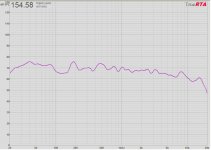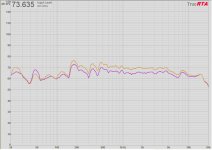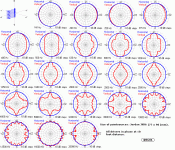Are you going to put them in corners to get the most bass out of them?
I'll use them with sealed sub crossed over at ~130hz. The array is running full range with the sealed box good to about that number.
The speaker binding posts are on the side in case we put them on the wall as does Ted.
One side up and running. Tomorrow the other. Lots of fiddly wiring with these little gems.
Regards
brian
Attachments
What is nflawp?
We have the pair running now. Still experimenting with placement as they don't sound their best in the 4 driver floor position.
First impressions are greater dynamics (which was the motivation for this exercise) and more directional. I can hear some mild combing with a 6khz sine wave. Not so apparent with program material. The extra sensitivity is welcome but may need to be sacrificed with some compensation to flatten the midrange and elevate the treble. Subjective image height is to the ceiling now and beyond the speakers.
Attached a quick and dirty fr measurement. As usual <200hz is room related and >10K is suspect as mic not calibrated. But it gives the general idea of reducing output >3K. Speakers are toed in 30 degrees.
Brian
We have the pair running now. Still experimenting with placement as they don't sound their best in the 4 driver floor position.
First impressions are greater dynamics (which was the motivation for this exercise) and more directional. I can hear some mild combing with a 6khz sine wave. Not so apparent with program material. The extra sensitivity is welcome but may need to be sacrificed with some compensation to flatten the midrange and elevate the treble. Subjective image height is to the ceiling now and beyond the speakers.
Attached a quick and dirty fr measurement. As usual <200hz is room related and >10K is suspect as mic not calibrated. But it gives the general idea of reducing output >3K. Speakers are toed in 30 degrees.
Brian
Attachments
Required reading (IMO) for anyone designing a home audio linear array:bcherry said:What is nflawp?
http://www.google.com/search?hl=en&lr=&q=nflawp&btnI=I'm+Feeling+Lucky
It explains the power tapering arrangement to which I referred. "Power tapering" sounds complicated, it's really just a different way of arranging the series/parallel wiring to the array, giving drivers toward the center more power than the upper and lower ones. The precedence effect means that combing and time-delay "bloom" are mitigated.
Typhoon 3 in Hong Kong today
raining and windy but looks like it will miss us and hit Hainan Island, just in case you wondered.
nflwap: thanks. I clued in. Read it several times and will keep power tapering on the agenda.
Today I experimented with compensation with variable wire wound and found best result at 4ohms/2u2 as attached. Bottom line is w/o comp so you can see how the 4r/2u2 flattens out the bulge and gives some relative lift to the >3K fr. This was without the subs engaged! so gives an idea of the low fr background noise we have here. A lot of pile drivers and cranes operating in Mongkok and walking on the street feels like we're floating on a bowl of jelly. The 9 drivers die at about 170hz just before the bump.
Also discovered with the 4ohm in place that the net DCR is 8.5ohms and sounds best on 16ohm taps and about 2-3db more output. Hmmm, that probably means the 4 driver array at 4.6ohms DCR will sound best on the 8 ohm taps. Real Z is probably closer to 8ohms than 4ohms for this driver.
The 4r/2uf gives a net loss of about 4db so not too bad and speakers still sound lively and pretty good efficiency.
Those are my subjective conclusions at this time and welcome to read comments explaining where wrong.
Brian
raining and windy but looks like it will miss us and hit Hainan Island, just in case you wondered.
nflwap: thanks. I clued in. Read it several times and will keep power tapering on the agenda.
Today I experimented with compensation with variable wire wound and found best result at 4ohms/2u2 as attached. Bottom line is w/o comp so you can see how the 4r/2u2 flattens out the bulge and gives some relative lift to the >3K fr. This was without the subs engaged! so gives an idea of the low fr background noise we have here. A lot of pile drivers and cranes operating in Mongkok and walking on the street feels like we're floating on a bowl of jelly. The 9 drivers die at about 170hz just before the bump.
Also discovered with the 4ohm in place that the net DCR is 8.5ohms and sounds best on 16ohm taps and about 2-3db more output. Hmmm, that probably means the 4 driver array at 4.6ohms DCR will sound best on the 8 ohm taps. Real Z is probably closer to 8ohms than 4ohms for this driver.
The 4r/2uf gives a net loss of about 4db so not too bad and speakers still sound lively and pretty good efficiency.
Those are my subjective conclusions at this time and welcome to read comments explaining where wrong.
Brian
Attachments
Re: Typhoon 3 in Hong Kong today
An interesting note:
OTL amp "people" have experimented with this a LOT - the consensus seems to be 14.5 Ohms for a resistive 8 Ohm load. Extrapolate from there for differing values. Apparently it gives just the right dampening for the best decay character in the midrange and lower treble. Obviously this may or may not be the case for wild swings in impeadance (..as often seen at lower freq.s with most drivers/loading schemes). Incedentally, I think Nelson Pass arrived at just about this figure for the output impeadance of the First Watt F2. So yes, according to many others, your conclusions are "sound".
Oh, with regard to your variable resistor, resistors can do more harm than any other component in a passive crossover. AFTER you have the value you want - then wind your own (replacing the variable), and the sound should improve substantially.
http://www.diyaudio.com/forums/showthread.php?s=&threadid=21920&highlight=
bcherry said:
Also discovered with the 4ohm in place that the net DCR is 8.5ohms and sounds best on 16ohm taps and about 2-3db more output. Hmmm, that probably means the 4 driver array at 4.6ohms DCR will sound best on the 8 ohm taps.
An interesting note:
OTL amp "people" have experimented with this a LOT - the consensus seems to be 14.5 Ohms for a resistive 8 Ohm load. Extrapolate from there for differing values. Apparently it gives just the right dampening for the best decay character in the midrange and lower treble. Obviously this may or may not be the case for wild swings in impeadance (..as often seen at lower freq.s with most drivers/loading schemes). Incedentally, I think Nelson Pass arrived at just about this figure for the output impeadance of the First Watt F2. So yes, according to many others, your conclusions are "sound".
Oh, with regard to your variable resistor, resistors can do more harm than any other component in a passive crossover. AFTER you have the value you want - then wind your own (replacing the variable), and the sound should improve substantially.
http://www.diyaudio.com/forums/showthread.php?s=&threadid=21920&highlight=
Oh, with regard to your variable resistor, resistors can do more harm than any other component in a passive crossover. AFTER you have the value you want - then wind your own (replacing the variable), and the sound should improve substantially.
Yes agreed and already done. I use a 4r NI 30 watt ww. And the sound is much more cohesive.
The Jordan rep came around today to listen and he mentioned the surrounds on this driver take about 50-100hrs to stretch and for the Fo to come down. That may explain the bump at 170hz as, based on the cabinet volume it should be lower. Will have to play something that gets the drivers excursing. I remember that the 4 driver array took about a month to loosen up.
Anyone have any experience driving linear arrays with tube amp, particularly SET 300B? Although the efficiency and impedance indicate a good match, I'm getting clipping at moderately loud levels. Using a 40w EL34 pp there is no clipping. I'm wondering if all that motor power is drinking up the current and we're into a high current/low voltage situation.
BTW, the 4 driver array doesn't clip.
Brian
Any comments on frequency plots?
As we earlier had much discussion about diminished hf output and other problems with a straight-up 9 driver array just curious to know if the last comp vs no comp plot is what is to be expected. The last plots I posted show the difference (only one speaker measured), basically without comp and amps connected straight in a drop of ~6db from 4k5 to ~15k. Is this better or worse than expected for a 9 x 50mm driver? The sound was a little on the shouty side.
The comp EQ is 4r/2u2 and sounds quite balanced now.
The other issue is directionalty and the image does shift a bit with different listening positions but about the same as many other speakers I've heard. Some mild combing noticeable at 6K sine wave but not noticeable when playing program.
So before I move on to variations on the theme just wonder if the result is about what was expected?
Brian
As we earlier had much discussion about diminished hf output and other problems with a straight-up 9 driver array just curious to know if the last comp vs no comp plot is what is to be expected. The last plots I posted show the difference (only one speaker measured), basically without comp and amps connected straight in a drop of ~6db from 4k5 to ~15k. Is this better or worse than expected for a 9 x 50mm driver? The sound was a little on the shouty side.
The comp EQ is 4r/2u2 and sounds quite balanced now.
The other issue is directionalty and the image does shift a bit with different listening positions but about the same as many other speakers I've heard. Some mild combing noticeable at 6K sine wave but not noticeable when playing program.
So before I move on to variations on the theme just wonder if the result is about what was expected?
Brian
Re: Any comments on frequency plots?
That actually sounds a bit better for the freq. response than I would have expected - likely due to the Jordan's rising treble response. The combing issue is typical (i.e. virtually in-audible with drivers spaced this closely), but there might be a slight loss in perceived "air" from a serious comb suck-out at the top of the driver's passband.
Don't forget that the addition of lower freq.s via a subwoofer will also balance-out the sound.. SO, while your eq. might sound perfect now, it might not with the inclusion of a sub.
Also, much like lowther's and similar "low mass vs. sd" drivers, getting a sub that will "blend" well with these could be difficult.
bcherry said:As we earlier had much discussion about diminished hf output and other problems with a straight-up 9 driver array just curious to know if the last comp vs no comp plot is what is to be expected. The last plots I posted show the difference (only one speaker measured), basically without comp and amps connected straight in a drop of ~6db from 4k5 to ~15k. Is this better or worse than expected for a 9 x 50mm driver? The sound was a little on the shouty side.
The comp EQ is 4r/2u2 and sounds quite balanced now.
The other issue is directionalty and the image does shift a bit with different listening positions but about the same as many other speakers I've heard. Some mild combing noticeable at 6K sine wave but not noticeable when playing program.
So before I move on to variations on the theme just wonder if the result is about what was expected?
Brian
That actually sounds a bit better for the freq. response than I would have expected - likely due to the Jordan's rising treble response. The combing issue is typical (i.e. virtually in-audible with drivers spaced this closely), but there might be a slight loss in perceived "air" from a serious comb suck-out at the top of the driver's passband.
Don't forget that the addition of lower freq.s via a subwoofer will also balance-out the sound.. SO, while your eq. might sound perfect now, it might not with the inclusion of a sub.
Also, much like lowther's and similar "low mass vs. sd" drivers, getting a sub that will "blend" well with these could be difficult.
there might be a slight loss in perceived "air" from a serious comb suck-out at the top of the driver's passband.
Where the submitted point source plots shows suck outs, the Jordan array has proportional lower ones and probably perfect dispersion up to over 3 kHz.
The plots can be used for extrapolating the real off axis response too.
B
Attachments
bjorno said:
Where the submitted point source plots shows suck outs, the Jordan array has proportional lower ones and probably perfect dispersion up to over 3 kHz.
The plots can be used for extrapolating the real off axis response too.
B
Ah.. BLUE is the horizontal dispersion.
Reality and modeled responses will diverge here (at least for most graphical displays). It would likely need to be a continous freq. response rather than discreet plots. Furthermore, there should not be any averaging.
The Kuze uses similar diameter driver/frames to the Jordan and here you can see the effects (..though of course some of this "hash" is endemic to the driver):
http://www.partsexpress.com/projectshowcase/Kuze3201/Kuze3201weqnosmooth.jpg
I have build an 4 array, look att the link its in swedish byt look att the pictures. I have an Eq on theme now an DBX 260 but am gone build an passiv filter whit an high freq compensation i think they need more over 10khz. I runing then whit 4 sub whit 1 8" seas woofer each
http://www.hififorum.nu/forum/topic.asp?TOPIC_ID=59025
Bengt
http://www.hififorum.nu/forum/topic.asp?TOPIC_ID=59025
Bengt
- Status
- This old topic is closed. If you want to reopen this topic, contact a moderator using the "Report Post" button.
- Home
- Loudspeakers
- Full Range
- Jordan JX6 full-range line array



